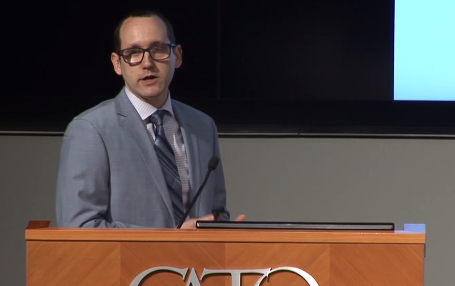Why is College So Pricey?

Conservatives and progressives both agree that attending college has become an enormous financial burden. They disagree, however, about the causes of this problem. Douglas Webber, Professor of Economics at Temple University, Jason Delisle, Resident Fellow at the American Enterprise Institute and Neal McCluskey, Director of the Cato Institute’s Center for Educational Freedom, discussed possible causes of high college prices and what can be done to lower them.
Professor Douglas Webber discussed some of the most common theories as to why college has become so expensive. College faculty often attribute high tuition to administrative bloat. Webber conceded that “…in the 80s and 90s there were big increases in administrative spending,” but also said “It’s been less since then, so you can’t really explain much of the more recent increase based on administrative bloat.”
He condemns excessive student amenities such as lazy rivers, but points out that they are “…much more concentrated among what we typically call the ‘elite colleges’…” Webber also mentioned the idea of Baumol’s Cost Disease, an explanation that he finds more convincing than the previous ones.
Baumol’s Cost Disease is the idea that since“…the returns to a PhD in the private sector have gone up quite a bit over time…this means that over time, to get the exact same quality person a school has to pay more but it does not get any more productivity for it.” Webber advocated a liberal approach to solve this problem, saying: “…investment in education technology and improving productivity in education are what you need to attack the cost disease.”
Despite being conservative, Jason Delisle offered an explanation for high college prices that differed from that of his fellow conservatives. Conservatives tend to believe the Bennett Hypothesis, which claims that federal student aid is enabling colleges to inflate their prices. Delisle said: “I actually think that conservatives and free market supporters are overinvested in this Bennett Hypothesis issue. I think it has really dominated how they think about and care about higher education policy and how they look at government intervention in higher education.”
Conservatives, according to Delisle, are missing the fact that: “You could have a big increase in government support for higher education through Pell grants and student loans and actually not get an increase in price but actually induce a whole bunch of students who are on the margin of whether or not they are qualified for a particular program.” By bringing in all of these new students, “…you’ve actually changed the makeup of the student body and you’ve also changed the number of students who are entering the job market with those degrees, and so you are actually changing and affecting the market perhaps in a bad way…” To make headway on the issue of college pricing, Delisle said conservatives “…should be looking more at value and a price vs. earnings comparison as a way of determining if the government money is doing good things or bad things and if people are getting what they pay for in these programs instead of constantly worrying about prices.”
Neal McCluskey defended the Bennett Hypothesis. The main idea, he believes, is that federal aid does not automatically mean that universities raise prices, but it does enable them to do it. He said: “It is not the lazy rivers that are causing the price increase—I look at them as a symptom of a system that may have a lot of third-party money that enables people to demand things that have very little to do with what they are in that place for, which is education.”
The fact that room and board prices have increased presents a problem for Baumol’s Cost Disease. This is because students working for their PhDs have little need for food services and dormitories. To summarize his position, McCluskey said“…colleges and the people in them are kind of like everyone else. They are generally trying to maximize their utility…but a lot of it does require money and they are enabled to get a lot of that money because aid gives it to the students who then become the source of it.”




